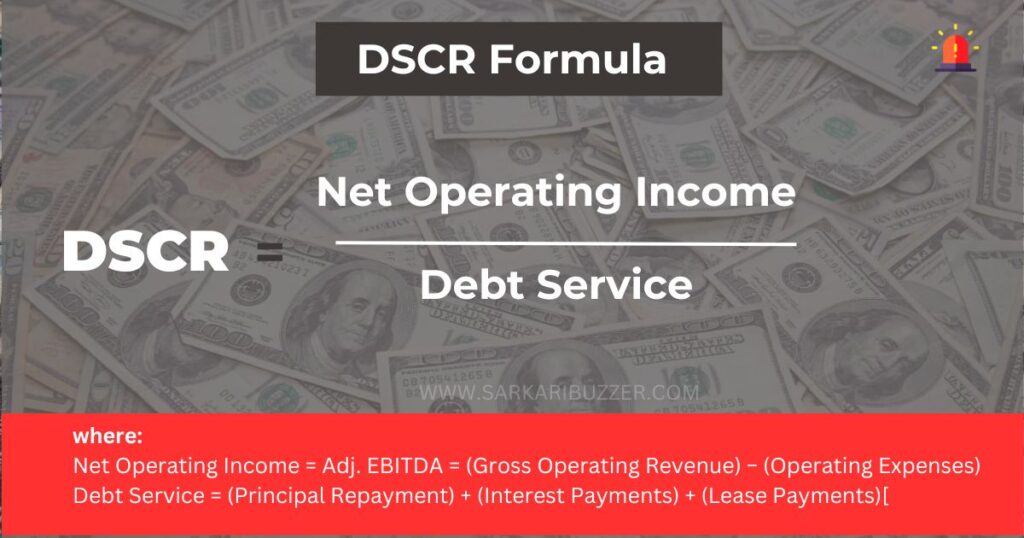DSCR Loan: DSCR Loan Pros and Cons in 2024, Get A Loan Today Are you also looking for a dscr loan’s Pros and cons and you want to know about DSCR Loans and what is DSCR? then you are at right place, in this article we will explain what is DSCR Loan and what are its Benefits to taking the loan in 2024.
What is DSCR Loan?
The debt service coverage ratio (DSCR), also called the “debt coverage ratio” (DCR), is a way to see if a business or person can make enough money to pay their debts. These debts might include things like loan payments, interest, and rent.
To find the DSCR, you divide the money the business or person makes by the total amount they owe for their debts.
If the DSCR is high, it means they have a good chance of paying off their debts. This makes it easier for them to borrow money from banks.
Banks and lenders often set a minimum DSCR as a rule. If the DSCR falls below this minimum, it could be seen as a sign that the person or business might not be able to pay back their loans.
Formula of DSCR Loan?
To figure out the debt coverage ratio (DSCR), you need to do two things:

- First, find the net operating income (NOI). This is how much money a business makes after subtracting all its operating expenses from its revenue.
- Then, add up all the costs and payments related to financing, like interest payments and lease payments. This is called the debt service.
Once you have these two numbers, you divide the net operating income by the debt service to get the DSCR.
The net operating income tells us how well the business is doing without considering financing costs. The debt service tells us how much money the business has to pay to cover its debts.
A higher DSCR means the business is in a better position to pay off its debts.
Example of DSCR Loan Formula
Let’s say you have a small business that earns $100,000 in gross revenue (total income) per year. After subtracting all operating expenses, like salaries, rent, and utilities, the net operating income (NOI) comes out to be $60,000.
Now, let’s say the business has a loan that requires them to make annual payments totalling $40,000, which includes both principal repayment and interest.To find the debt coverage ratio (DSCR), we use the formula:

So, the DSCR for this business is 1.5.
This means that for every dollar the business owes in debt payments, it earns $1.50 in operating income. A DSCR of 1.5 suggests that the business is in a relatively good financial position to cover its debt obligations.
DSCR Loan Pros and Cons
Let’s Now Discuss about DSCR Loan Pros and Cons, Everything has own pros and cons.
Pros of Taking DSCR Loan in 2024
Let’s break down the advantages of choosing a DSCR loan for financing your commercial property:
- Better Interest Rates: DSCR loans often have lower interest rates compared to regular commercial loans. This means you could save a lot of money over the loan term.
- Longer Payment Periods: With DSCR loans, you get more time to pay back what you owe. This makes your monthly payments easier to manage, especially for commercial property investors.
- More Flexible Terms: DSCR loans offer different options for structuring your loan. You can customize it to fit your needs, like having periods where you only pay interest or arranging for balloon payments.
- Higher Loan Limits: You can borrow larger amounts with DSCR financing, which is great for big real estate projects or investments.
- Better Cash Flow: DSCR loans focus on the income potential of your property. This means you’ll likely see an improvement in your cash flow, leading to a stronger financial position.
Also Check Those Topics
Cons of Taking DSCR Loan in 2024
While DSCR loans come with numerous benefits, it’s important to understand their potential drawbacks:
- Tough Qualification Criteria: DSCR loans often demand a higher credit score and extensive financial background, which could pose challenges for some borrowers in qualifying.
- Risk Associated with Property Performance: Since DSCR loans rely on property income, a decline in property performance could make it difficult for borrowers to meet their financial commitments.
- Variable Interest Rates: Certain DSCR loans feature variable interest rates, leading to uncertainty in monthly payments and potential budgeting challenges.
- Prepayment Penalties: Borrowers might encounter penalties for paying off their DSCR loans ahead of schedule, restricting flexibility in refinancing or selling the property.
- Specific Property Requirements: DSCR loans are typically tied to particular property types, limiting their suitability for various real estate ventures and potentially excluding certain borrowers.
Conclusion of DSCR Loan Pros and Cons
In conclusion, DSCR loans present a compelling option for commercial property financing, offering a range of advantages such as lower interest rates, longer repayment terms, and flexible loan structures. These benefits can significantly enhance cash flow and support larger real estate projects. However, it’s crucial to consider the drawbacks, including stringent qualification requirements, potential risks associated with property performance, and variable interest rates.
Understanding both the pros and cons allows borrowers to make informed decisions that align with their financial goals and circumstances. By weighing these factors carefully, individuals and businesses can effectively leverage DSCR loans to achieve their objectives while mitigating associated risks.

